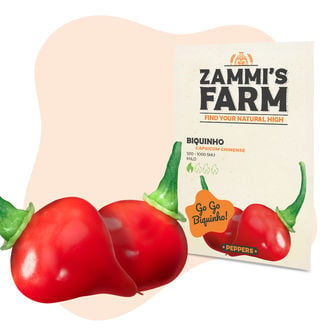Biquinho Seeds
These chillies are super mild, rating only 500-1,000 SHU. This means they are perfect for those with a very low spice tolerance, or just lovers of salad who want to give it a little bit of edge. Couple that with a relatively rapid growth, and you get a chilli well suited to beginners.
Biquinho Seeds: Fruity, Crunchy, and Tangy
Biquinho chillies are the perfect introduction to both spice and chilli growing. Mild, with a Scoville rating of only 500–1,000, they’re a safe bet; perfect for a first grow to discover if it’s something you’d like to pursue.
Named Biquinho ("little beak") on account of their small, beak-like tip, they originate in Brazil. Being sweet and crunchy, they’re not just suited to cooking, but are perfect for adding whole and raw into salads, too.
How To Grow Biquinho Chillies
- Step 1: Germination
Germinating chilli seeds is a fairly simple process. The easiest method is to germinate them in their final pots. The exact size of the containers depends on your setup and goals. But bear in mind; the bigger the pot, the longer the maturation time, but the bigger the harvest.
Bury seeds around 1cm deep into soil, and leave them in a warm space. They don’t need light, but it won’t hurt either. Keep them moist but not wet. They do, however, require high humidity to germinate, so you mustn’t let them dry out. Placing cling film over the top of the pot will help to retain moisture. Just poke a few holes in it so it can breathe. A temperature range of around 25–28°C is ideal for germination.
Once the seedlings appear, remove the cling film and move them to a well-lit space.
- Step 2: Patience
Now you just have to care for your chillies until they’re ready to harvest. Water them as you would a normal house plant.
Using a pepper/tomato feed should be suitable. However, you may want to add a little extra calcium to prevent problems during fruiting. The best way to do this is via a foliar spray.
How and When To Harvest Biquinho Chillies
Depending on the size of their pots, the amount of time your chilli plants take to reach harvest will differ. It will likely fall between 100 and 120 days, but it’s best to take the cues from the peppers themselves. You’ll know they’re ripe when they’re red. Once they initially turn red, give it a few more days before harvesting.
To harvest, simply pluck them from the plant by pulling them upwards. If they give a lot of resistance, they are not fully ripe. If they come away easily, they’re ready to eat!
A Word of Warning
Handling chillies and their seeds regularly can result in pepper burn. While this is unlikely with Biquinhos because they are so mild, it’s still good practice to wear gloves if you handle chillies a lot.
Note: The packaging for this product may contain incorrect information. Please refer to this page for correct information about Zamnesia's Biquinho seeds.
| Colour | Red |
|---|---|
| Harvesting Period | May–July |
| Maturation time | ~100 days |
| Sowing | March–April |
| Botanical Name | Capsicum chinense |
| Suitable For | Outside |
| Plant Type | Pepper |
| Location | In pot, In soil |
| Watering Schedule | Regularly |
| Amount of Sun | Full sun |
| Required Space | 45x85 |
| Advised Technique | Transplant, Plant out, Support plants |
| Sowing period under glass | January, February, March |
| Outdoor sowing period | March, April |
| Harvest period | July, August, September |
| Uses | Edible |
| Poisonous | No |
| Frost Resistant | No |
| Lifespan | Perennial |
| Package contents | Ca. 6 seeds |
| Average Height | ~85cm |
| Spiciness (SHU) | Mild (500–1,000 SHU) |
More information related to this product:
Hohe Keimrate
Es sind fast alle Samen gekeimt, soweit alles i.O.
Top
Bin zufrieden
Super
Je connais bien ces petits piments que j'ai déjà goûter au Brésil hâte de les voir pousser chez moi.
ottimo
alta germinazione
Prachtige pepers
Prachtige pepers, niet te heet, en makkelijk te kweken.
Bien
Germe bien et démarre bien
Naja
Also, aus den 10 Samen sind nicht viele was geworden. Kann aber auch daran liegen, 2024 hat es lange geregnet und es war sehr dunkel. Deswegen können vielleicht nicht die Samen was dafür sondern auch das Wetter.
Mfg Maddin
Ottime piante
poco piccanti ma assai saporiti.
Perfect
Alle gekeimt!
Hatte sie in einem 3l Topf - die nächsten in einem 14l Topf
Im großem Topf deutlich besser Wuchs und die Ernte gut 200% mehr.
Hermosa planta
Me germinaron bien, las tengo bien crecidas con alguna flor, estas plantas necesitan mucho Sol directo para que crezcan bien.









 United States
United States
























